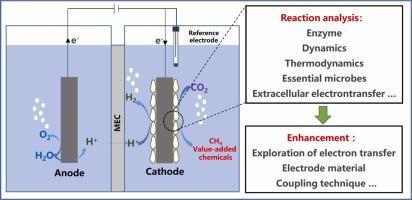当前位置:
X-MOL 学术
›
Process Saf. Environ. Prot.
›
论文详情
Our official English website, www.x-mol.net, welcomes your feedback! (Note: you will need to create a separate account there.)
Thermodynamics and electron transfer mechanisms of CO2 bioelectroconversion to value-added chemicals: A state-of-the–art review
Process Safety and Environmental Protection ( IF 6.9 ) Pub Date : 2024-06-26 , DOI: 10.1016/j.psep.2024.06.102 Guangyin Zhen , Zhongyi Zhang , Jiandong Wang , Teng Cai , Na Wang , Guihua Zhuo , Xueqin Lu
Process Safety and Environmental Protection ( IF 6.9 ) Pub Date : 2024-06-26 , DOI: 10.1016/j.psep.2024.06.102 Guangyin Zhen , Zhongyi Zhang , Jiandong Wang , Teng Cai , Na Wang , Guihua Zhuo , Xueqin Lu

|
The bioelectroreduction of CO to value-added chemical commodities, by bioeletrochemical system (BES), represents a promising approach for alleviating both energy crisis and global warming. Although a wide variety of studies have been undertaken to improve the efficiency of CO bioelectroconversion and speculate electron pathways of electroactive microorganisms, the underlying mechanisms of CO bioelectroconversion are still not fully understood. A much more comprehensive understanding of electron utilization mechanisms would be helpful to the practical applications of bioelectrosynthesis. Here, the working principles in bio-electrochemical CO reduction were summarized, and the change of Gibbs free energy (ΔG) and dynamics for CO bioelectroconversion were analyzed to evaluate the potential effects of external microenvironment changes (e.g., operational conditions, supply of mediators/conductive materials, electro-activity of key functional microbes, arious redox potentials of cellular redox compounds, etc.) on CO bioelectroconversion and the electron transfer chains of bioelectrocatalysis. The potential electron transfer mechanisms for CO bioelectroconversion to multi-carbon commodities were further summarized. Particularly, the functional proteins and genes associated with the metabolic pathway of CO electroreduction were discussed. Finally, taking the CO-reducing pathways of methanogenic archaea as an example, the electron transfer pathways were illustrated in details, and the future perspectives for the possible improvement and research interests in bioelectrosynthesis of CO capture and use were elaborated. This paper reviews the thermodynamics and electron transfer mechanisms of CO bioelectroconversion, and provided the guidance for the practical implementations of employing and electrochemically manipulating electroactive functional microorganisms to electrocatalyze CO to value-added low-carbon commodities.
中文翻译:

二氧化碳生物电转化为增值化学品的热力学和电子转移机制:最新综述
通过生物电化学系统(BES)将二氧化碳生物电还原为增值化学商品,是缓解能源危机和全球变暖的一种有前途的方法。尽管已经进行了大量的研究来提高CO生物电转化的效率并推测电活性微生物的电子途径,但CO生物电转化的潜在机制仍不完全清楚。对电子利用机制的更全面的了解将有助于生物电合成的实际应用。在此,总结了生物电化学CO还原的工作原理,并分析了CO生物电转化的吉布斯自由能(ΔG)和动力学的变化,以评估外部微环境变化(例如操作条件、介体的供应/导电材料、关键功能微生物的电活性、细胞氧化还原化合物的各种氧化还原电位等)对CO生物电转化和生物电催化的电子传递链的影响。进一步总结了CO生物电转化为多碳商品的潜在电子转移机制。特别是,讨论了与CO电还原代谢途径相关的功能蛋白和基因。最后,以产甲烷古菌的CO还原途径为例,详细阐述了电子传递途径,并阐述了生物电合成CO捕获和利用的可能改进和研究兴趣的未来前景。 本文综述了CO生物电转化的热力学和电子传递机制,为利用和电化学操作电活性功能微生物将CO电催化转化为增值低碳商品的实际实现提供了指导。
更新日期:2024-06-26
中文翻译:

二氧化碳生物电转化为增值化学品的热力学和电子转移机制:最新综述
通过生物电化学系统(BES)将二氧化碳生物电还原为增值化学商品,是缓解能源危机和全球变暖的一种有前途的方法。尽管已经进行了大量的研究来提高CO生物电转化的效率并推测电活性微生物的电子途径,但CO生物电转化的潜在机制仍不完全清楚。对电子利用机制的更全面的了解将有助于生物电合成的实际应用。在此,总结了生物电化学CO还原的工作原理,并分析了CO生物电转化的吉布斯自由能(ΔG)和动力学的变化,以评估外部微环境变化(例如操作条件、介体的供应/导电材料、关键功能微生物的电活性、细胞氧化还原化合物的各种氧化还原电位等)对CO生物电转化和生物电催化的电子传递链的影响。进一步总结了CO生物电转化为多碳商品的潜在电子转移机制。特别是,讨论了与CO电还原代谢途径相关的功能蛋白和基因。最后,以产甲烷古菌的CO还原途径为例,详细阐述了电子传递途径,并阐述了生物电合成CO捕获和利用的可能改进和研究兴趣的未来前景。 本文综述了CO生物电转化的热力学和电子传递机制,为利用和电化学操作电活性功能微生物将CO电催化转化为增值低碳商品的实际实现提供了指导。











































 京公网安备 11010802027423号
京公网安备 11010802027423号